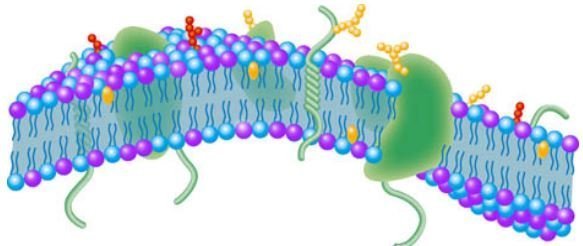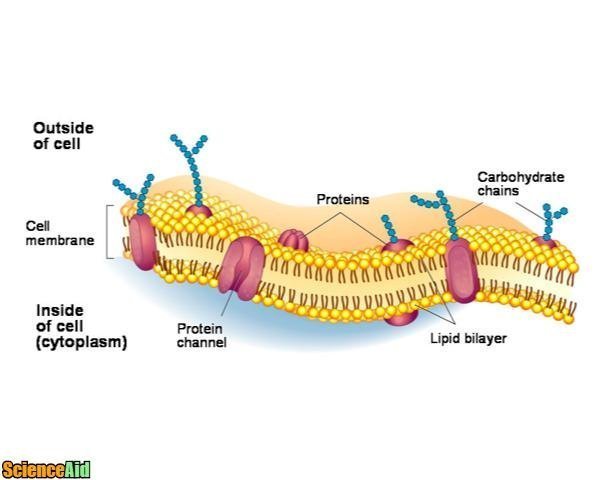The Plasma Membrane: Gateway to the Cell
Edited by Chameleon, Jen Moreau, SarMal, Sharingknowledge
Cells are separated from the external environment by a thin but complex structure called the plasma membrane (also known as the cell membrane). The cell plasma is crucial to the life of cells because it helps to keep the intracellular conditions balanced, a state called homeostasis. This balance is achieved through a series of mechanisms that control what enters and leaves the cell. The plasma membrane is elastic and allows unicellular organisms to move.
Figure 1. A simple view of plasma membrane.The blue and purple spheres represent Phospholipids, the cholesterol are the small yellow ovals throughout, the chains protruding from the top are carbohydrate chains, glycoproteins, and glycolipids while the large green ovals represent globular proteins.
Discovery of the Structure of the Cell Membrane
- 1In 1935, the English biologists Hugh Davson and James Danielli proposed a model that describes a phospholipid bilayer that extends between two layers of proteins. When clear electron micrographs of membranes became available, they appeared to show support for this model, showing a three-layered structure: the phospholipid bilayer (light) surrounded by two layers of protein (dark).The Davson Danielli model:Advertisement
Figure 2. Evidence for the Davson Danielli model. You can see what Davson and Danielli saw including the three layer structure containing one layer of phospholipid and two layers of protein.
- 1By the end of the 1960s, new evidence and discoveries challenged the viability of the Davson Danielli model. These challenges included:Challenges to the Davson Danielli Model:
- Scientists discovered the amount and type of membrane proteins are very diverse between different kinds of cells.
- The Davson Danielli model did not demonstrate precisely how the plasma membrane could change its shape without breaking bonds between proteins.
- Given that membrane proteins are hydrophobic molecules, they should not materialize in the aqueous cytoplasm and the extracellular environment.
Development
- 1In 1966, biologist Daniel Branton used freeze-fracturing to split cell membranes between the two lipid layers, revealing a 3D view of the smooth surface with small bumps sticking up and out. These were later identified as proteins. Figure 3. Evidence from freeze fracturing. Take note of the difference between the two, most notably the small bumps in the lower figure.Freeze Fracturing:
- 2Jonathan Singer and Garth Nicholson, proposed the fluid mosaic model in 1972. It was called fluid because phospholipids and proteins can move side by side as individual molecules inside the layer, like a liquid; and mosaic because when membranes are viewed from above they show a pattern produced by the scattered protein molecules (as in a mosaic). The model suggested that the proteins should be inside the phospholipid bilayer, not outside. This has become the accepted model to describe the structure of cell membrane. Figure 4. The fluid mosaic model containing phospholipids and proteins.The Fluid Mosaic Model:
Structure of the Cell Membrane
The plasma membrane is made of two layers of phospholipids with hydrophilic (water loving) polar heads and hydrophobic (water-fearing) non-polar tails making the membrane "amphipathic" and selective in what crosses. The lipid bilayer allows fatty molecules pass easily but does not allow polar molecules to pass (semi-permeable membrane). Ions, hydrophilic molecules larger than water, and large molecules such as proteins do not move through the membrane on their own but have special transports that allow their passage through the membrane.
Figure 5. The general structure of cell membrane.
Cell Membrane Components
- Phospholipids: Fat molecules formed by two (non-polar) fatty acids chains, a (polar) head containing a phosphate group, and glycerol.
- Cholesterol: Lipid molecule that adds rigidity to the plasma membrane preventing it of becoming overly fluid, but also helps to retain its fluidity.
- Carbohydrates (sugars): Including glycoproteins, sugar molecules covalently bound to proteins, and also some glycolipids, sugar molecules covalently bound to lipids.
- Proteins: Perform several biological functions. Figure 6. This illustrates the membrane components. You can clearly identify each of the four components of the cell membrane.
Function of Proteins
Some proteins function as transporters, allowing the cell to exchange molecules with its environment, while others are used to receive messages from the extracellular environment into the cytoplasm, termed receptors. Enzymes specialize in the catalysis (acceleration) of chemical reactions that occur inside the cell. Some proteins amplify the signals inside the cell, working as transducers and other proteins give support to the cell by anchoring to the cytoskeleton.
Function of Plasma Membranes
Plasma Membranes have several important functions other than cell permeability including *Protection: Retain the cellular elements inside the cell.
- Transport: Permit selected molecules to transit in and out of the cells.
- Organization: Isolate organelles from the rest of the cytoplasm, allowing cellular processes to occur separately.
- Communication: Enable the cell receives messages from the extracellular environment and allow responses according to the signals received.
- Movement: Allow a cell to change shape, provide anchoring sites for filaments of cytoskeleton (the skeleton of the cell).
- Recognition: Allow the cell to be identified and recognized by other cells, or even molecules. Figure 7. Permeability of the cell membrane.
The plasma membrane is a complex and dynamic structure that allows the cell to perform all the functions necessary for its survival, such as moving, taking nutrients from the extracellular environment, eliminating toxins and unnecessary elements.
Referencing this Article
If you need to reference this article in your work, you can copy-paste the following depending on your required format:
APA (American Psychological Association)
The Plasma Membrane: Gateway to the Cell. (2017). In ScienceAid. Retrieved Apr 26, 2024, from https://scienceaid.net/the_Plasma_Membrane:_Gateway_to_the_Cell
MLA (Modern Language Association) "The Plasma Membrane: Gateway to the Cell." ScienceAid, scienceaid.net/the_Plasma_Membrane:_Gateway_to_the_Cell Accessed 26 Apr 2024.
Chicago / Turabian ScienceAid.net. "The Plasma Membrane: Gateway to the Cell." Accessed Apr 26, 2024. https://scienceaid.net/the_Plasma_Membrane:_Gateway_to_the_Cell.
If you have problems with any of the steps in this article, please ask a question for more help, or post in the comments section below.
Comments
Article Info
Categories : Cell Biology
Recent edits by: SarMal, Jen Moreau, Chameleon















